语言学概论总试卷
《语言学概论》(试卷)
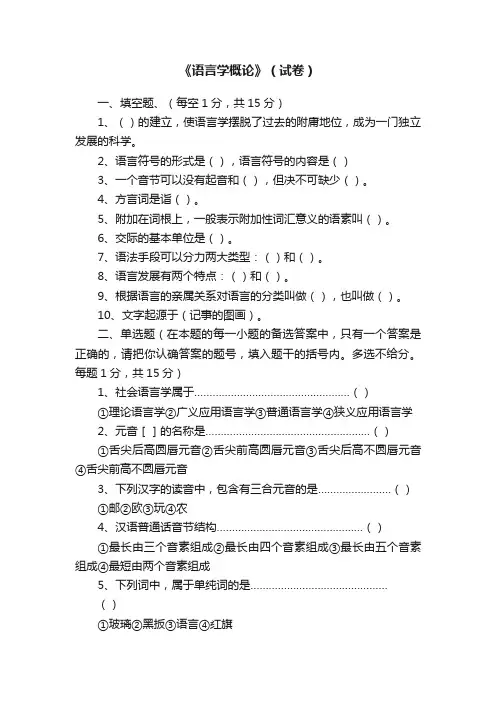
《语言学概论》(试卷)一、填空题、(每空1分,共15分)1、()的建立,使语言学摆脱了过去的附庸地位,成为一门独立发展的科学。
2、语言符号的形式是(),语言符号的内容是()3、一个音节可以没有起音和(),但决不可缺少()。
4、方言词是诣()。
5、附加在词根上,一般表示附加性词汇意义的语素叫()。
6、交际的基本单位是()。
7、语法手段可以分力两大类型:()和()。
8、语言发展有两个特点:()和()。
9、根据语言的亲属关系对语言的分类叫做(),也叫做()。
10、文字起源于(记事的图画)。
二、单选题(在本题的每一小题的备选答案中,只有一个答案是正确的,请把你认确答案的题号,填入题干的括号内。
多选不给分。
每题1分,共15分)1、社会语言学属于……………………………………………()①理论语言学②广义应用语言学③普通语言学④狭义应用语言学2、元音[]的名称是………………………………………………()①舌尖后高圆唇元音②舌尖前高圆唇元音③舌尖后高不圆唇元音④舌尖前高不圆唇元音3、下列汉字的读音中,包含有三合元音的是……………………()①邮②欧③玩④农4、汉语普通话音节结构…………………………………………()①最长由三个音素组成②最长由四个音素组成③最长由五个音素组成④最短由两个音素组成5、下列词中,属于单纯词的是………………………………………()①玻璃②黑扳③语言④红旗6、下列词中,属于复台词的是……………………………………()①傻子②席子③天子④椅子7、下列词组中,属于多义的是……………………………………()①两只学生送的花瓶②两位学生送的花瓶③两只学生送的花篮。
④两个学生送的花篮8、下列词中粗体的成分,属于同音关系的是………………………()①杜鲁门——杜绝②负荆一负担③忽然--突然④花朵——浪花9、英语的‘foot”(脚,单数)变为“feet”(脚,复数)运用的语法手段是……()①附加②异根③内部屈折④重叠10、汉语普通话中的:“卡通片”中的“卡”是一个…………()①语素②音节③前缀④词11、汉语中的:“了、着、过”在古代具有实实在在的词汇意义,到现代变成只表语义的助词,这于………………………………………………()①异化②类化③新语法范畴的形成④实词虚化12、下列语言中属于粘着语的是………………………………()①苗语②越南语③俄语④日语13、在一种语言内部划脑言时,最主要的依据是………………()①语法②语义③语音④词汇14、下列词的词义,属于词义缩小的是……………………………()①“皮”原指兽皮②“涕”原指眼泪③“瓦”原指一切烧好的上器④“江”原捐“长江”15、人类几种古老文字的原始字形,都是……………………()①象形的②会意的③表音的④形声的三、多选题(在本题的每一小题的备选答案中,正确答案有三个或三个以上多请把为正确答案的题号,填入题干的括号内。
【十套】语言学概论试题(含答案)
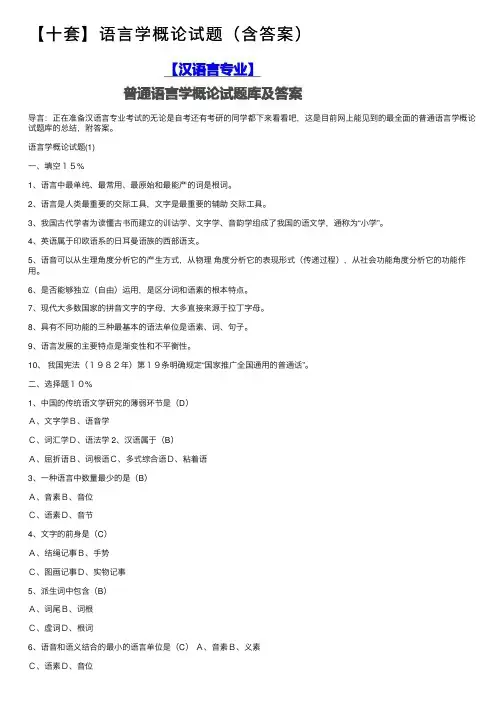
【⼗套】语⾔学概论试题(含答案)导⾔:正在准备汉语⾔专业考试的⽆论是⾃考还有考研的同学都下来看看吧,这是⽬前⽹上能见到的最全⾯的普通语⾔学概论试题库的总结,附答案。
语⾔学概论试题(1)⼀、填空15%1、语⾔中最单纯、最常⽤、最原始和最能产的词是根词。
2、语⾔是⼈类最重要的交际⼯具,⽂字是最重要的辅助交际⼯具。
3、我国古代学者为读懂古书⽽建⽴的训诂学、⽂字学、⾳韵学组成了我国的语⽂学,通称为“⼩学”。
4、英语属于印欧语系的⽇⽿曼语族的西部语⽀。
5、语⾳可以从⽣理⾓度分析它的产⽣⽅式,从物理⾓度分析它的表现形式(传递过程),从社会功能⾓度分析它的功能作⽤。
6、是否能够独⽴(⾃由)运⽤,是区分词和语素的根本特点。
7、现代⼤多数国家的拼⾳⽂字的字母,⼤多直接来源于拉丁字母。
8、具有不同功能的三种最基本的语法单位是语素、词、句⼦。
9、语⾔发展的主要特点是渐变性和不平衡性。
10、我国宪法(1982年)第19条明确规定“国家推⼴全国通⽤的普通话”。
⼆、选择题10%1、中国的传统语⽂学研究的薄弱环节是(D)A、⽂字学B、语⾳学C、词汇学D、语法学 2、汉语属于(B)A、屈折语B、词根语C、多式综合语D、粘着语3、⼀种语⾔中数量最少的是(B)A、⾳素B、⾳位C、语素D、⾳节4、⽂字的前⾝是(C)A、结绳记事B、⼿势C、图画记事D、实物记事5、派⽣词中包含(B)A、词尾B、词根C、虚词D、根词6、语⾳和语义结合的最⼩的语⾔单位是(C)A、⾳素B、义素C、语素D、⾳位7、汉语单词“忽然”出现的位置是(C)A、主语位置B、谓语位置C、状语位置D、定语位置8、以下各种语⾔变体中,属于社会⽅⾔的是(D)A、⼟话B、客家话C、客套话D、⿊话9、下列语素中属于⾃由语素的是(C)A、初B、视C、⼈D、民10、在语⾔结构的某⼀环节上能够互相替换,具有某种相同作⽤的各个单位之间所形成的关系叫(D)A、转换关系B、组合关系C、层级关系D、聚合关系三、名词解释20%1、专语语⾔学:以具体语⾔作为研究对象的语⾔学。
2023年自考专业(汉语言文学)《语言学概论》考试历年真题摘选附带答案
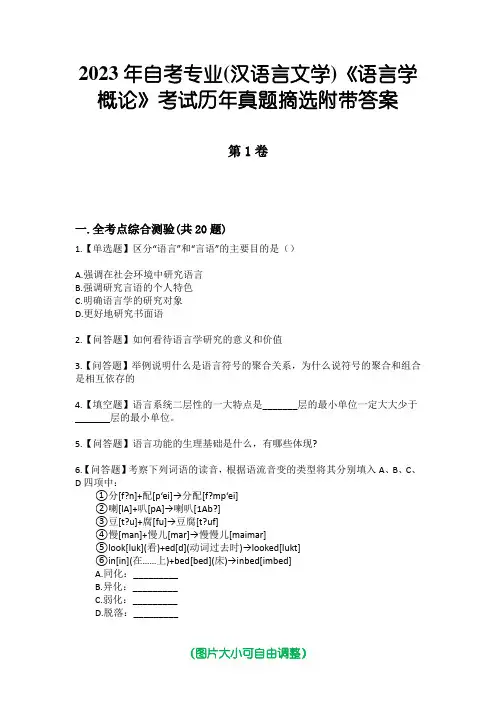
2023年自考专业(汉语言文学)《语言学概论》考试历年真题摘选附带答案第1卷一.全考点综合测验(共20题)1.【单选题】区分“语言”和“言语”的主要目的是()A.强调在社会环境中研究语言B.强调研究言语的个人特色C.明确语言学的研究对象D.更好地研究书面语2.【问答题】如何看待语言学研究的意义和价值3.【问答题】举例说明什么是语言符号的聚合关系,为什么说符号的聚合和组合是相互依存的4.【填空题】语言系统二层性的一大特点是_______层的最小单位一定大大少于_______层的最小单位。
5.【问答题】语言功能的生理基础是什么,有哪些体现?6.【问答题】考察下列词语的读音,根据语流音变的类型将其分别填入A、B、C、D四项中:①分[f?n]+配[p‘ei]→分配[f?mp‘ei]②喇[lA]+叭[pA]→喇叭[1Ab?]③豆[t?u]+腐[fu]→豆腐[t?uf]④慢[man]+慢儿[mar]→慢慢儿[maimar]⑤look[luk](看)+ed[d](动词过去时)→looked[lukt]⑥in[in](在……上)+bed[bed](床)→inbed[imbed]A.同化:_________B.异化:_________C.弱化:_________D.脱落:_________7.【填空题】语言的功能包括____ 功能和_______ 功能。
8.【填空题】语言符号的_______和_______,是语言符号的基本性质。
9.【问答题】举例说明语言特点对文字特点的影响。
10.【问答题】名词解释:义项11.12.【单选题】下列词语,属于绝对反义词的一组是()A.快—慢B.正—反C.好—坏D.黑—白13.【填空题】_______和________是语言系统中的两种根本关系。
14.【单选题】下列对“不可言传,只能意会”这句话的意思理解不正确的一项是()A.人的思维活动是不可能经过语言来进行的B.思维活动和语言表示有时可能会相互脱节C.不能绝对地说语言是抽象思维的唯一工具D.高度集中复杂的思维不可能完全凭借语言15.【问答题】“船来了”这一表述中的“船”,在具体运用中能够指渡轮、帆船、游艇等各种类型的船,但“船”的词义却是“水上运输和交通的工具”。
语言学概论
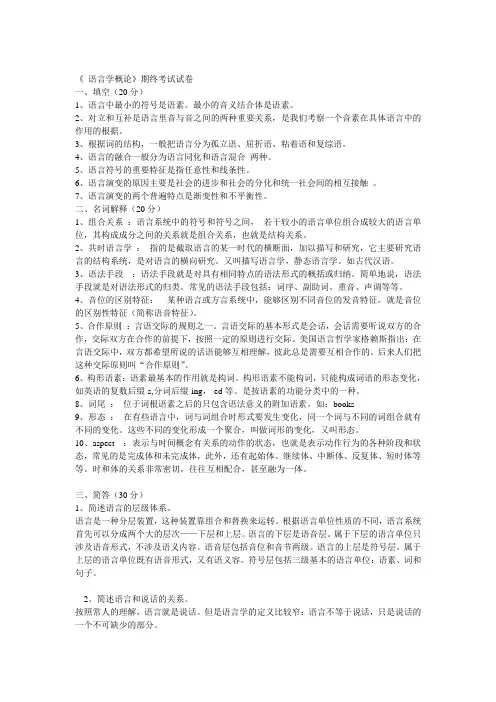
《语言学概论》期终考试试卷一、填空(20分)1、语言中最小的符号是语素。
最小的音义结合体是语素。
2、对立和互补是语言里音与音之间的两种重要关系,是我们考察一个音素在具体语言中的作用的根据。
3、根据词的结构,一般把语言分为孤立语、屈折语、粘着语和复综语。
4、语言的融合一般分为语言同化和语言混合两种。
5、语言符号的重要特征是指任意性和线条性。
6、语言演变的原因主要是社会的进步和社会的分化和统一社会间的相互接触。
7、语言演变的两个普遍特点是渐变性和不平衡性。
二、名词解释(20分)1、组合关系:语言系统中的符号和符号之间,若干较小的语言单位组合成较大的语言单位,其构成成分之间的关系就是组合关系,也就是结构关系。
2、共时语言学:指的是截取语言的某一时代的横断面,加以描写和研究,它主要研究语言的结构系统,是对语言的横向研究。
又叫描写语言学,静态语言学。
如古代汉语。
3、语法手段:语法手段就是对具有相同特点的语法形式的概括或归纳。
简单地说,语法手段就是对语法形式的归类。
常见的语法手段包括:词序、副助词、重音、声调等等。
4、音位的区别特征:某种语言或方言系统中,能够区别不同音位的发音特征,就是音位的区别性特征(简称语音特征)。
5、合作原则:言语交际的规则之一。
言语交际的基本形式是会话,会话需要听说双方的合作,交际双方在合作的前提下,按照一定的原则进行交际。
美国语言哲学家格赖斯指出:在言语交际中,双方都希望所说的话语能够互相理解,彼此总是需要互相合作的。
后来人们把这种交际原则叫“合作原则”。
6、构形语素:语素最基本的作用就是构词。
构形语素不能构词,只能构成词语的形态变化,如英语的复数后缀-s,分词后缀-ing,-ed等。
是按语素的功能分类中的一种。
8、词尾:位于词根语素之后的只包含语法意义的附加语素。
如:books9、形态:在有些语言中,词与词组合时形式要发生变化,同一个词与不同的词组合就有不同的变化。
这些不同的变化形成一个聚合,叫做词形的变化,又叫形态。
语言学概论 试卷全国自学考试
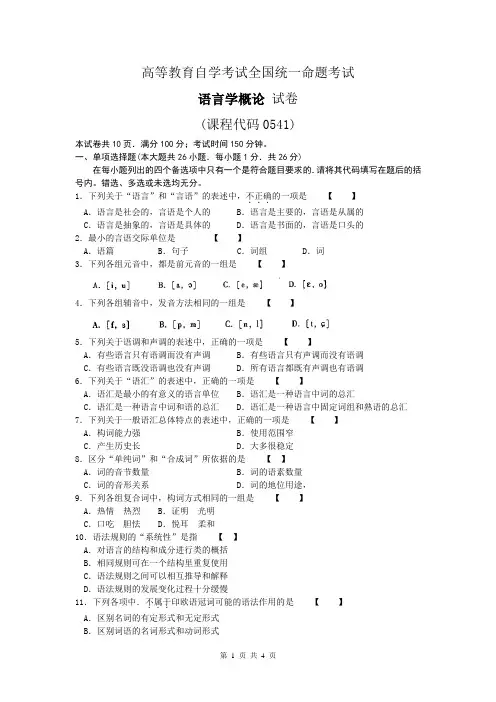
高等教育自学考试全国统一命题考试语言学概论试卷(课程代码0541)本试卷共10页.满分100分;考试时间150分钟。
一、单项选择题(本大题共26小题.每小题1分.共26分)在每小题列出的四个备选项中只有一个是符合题目要求的.请将其代码填写在题后的括号内。
错选、多选或未选均无分。
1.下列关于“语言”和“言语”的表述中,不正确...的一项是【】A.语言是社会的,言语是个人的B.语言是主要的,言语是从属的C.语言是抽象的,言语是具体的D.语言是书面的,言语是口头的2.最小的言语交际单位是【】A.语篇B.句子C.词组D.词3.下列各组元音中,都是前元音的一组是【】4.下列各组辅音中,发音方法相同的一组是【】5.下列关于语调和声调的表述中,正确的一项是【】A.有些语言只有语调而没有声调B.有些语言只有声调而没有语调C.有些语言既没语调也没有声调D.所有语言都既有声调也有语调6.下列关于“语汇”的表述中,正确的一项是【】A.语汇是最小的有意义的语言单位B.语汇是一种语言中词的总汇C.语汇是一种语言中词和语的总汇D.语汇是一种语言中固定词组和熟语的总汇7.下列关于一般语汇总体特点的表述中,正确的一项是【】A.构词能力强B.使用范围窄C.产生历史长D.大多很稳定8.区分“单纯词”和“合成词”所依据的是【】A.词的音节数量B.词的语素数量C.词的音形关系D.词的地位用途,9.下列各组复合词中,构词方式相同的一组是【】A.热情热烈 B.证明光明C.口吃胆怯 D.悦耳柔和10.语法规则的“系统性”是指【】A.对语言的结构和成分进行类的概括B.相同规则可在一个结构里重复使用C.语法规则之间可以相互推导和解释D.语法规则的发展变化过程十分缓慢11.下列各项中.不属于...印欧语冠词可能的语法作用的是【】A.区别名词的有定形式和无定形式B.区别词语的名词形式和动词形式C.区别名词的性的形式和数的形式D.区别动词的限定形式和非限定形式12.英语“Mike take a taxi”这句话是病句,其错误在于【】A.性B.数C.格D.态13.下列词组不属于“向心词组”的是【】A.参加比赛B.田径比赛C.认真比赛D.比赛结束14.下列关于语义民族性的表述中,正确的一项是【】A.词义上的民族特点并不明显B.词的多义化不受民族特点的制约C.不同的民族语言在词的理性意义上并无差异D.不同的民族语言在词的非理性意义上会有所不同15.下列各组词中.不属于同义词的一组是【】A.土豆马铃薯B.衣服衬衣C.情感感情D.结果成果16.“这家商店关门了”有歧义的原因是【】A.一词多义B.词语同形C.不同的层次构造D.不同的句法结构关系17.下列各组句子中,具有蕴含关系的一组是【】A.(甲)今天中秋节——(乙)今天吃月饼B.(甲)他买了一本小说——(乙)他买了一本书C.(甲)他打破了花瓶——(乙)花瓶被他打破了D.(甲)他们家的电视机坏了——(乙)他们家有电视机18.文字发展三阶段论认为,文字的发展从低级到高级经历的阶段分别为【】 A.象形文字、音节文字、音位文字B.表意文字、音位文字、音节文字C.象形文字、辅音文字、音节文字D.表意文字、表音文字、意音文字19.下列关于语言起源的学说中,注意到语言符号任意性的是【】A.神授说B.社会契约说C.摹声说 D.感叹说20.关于语言发展演变的原因。
(完整版)语言学概论试题及答案
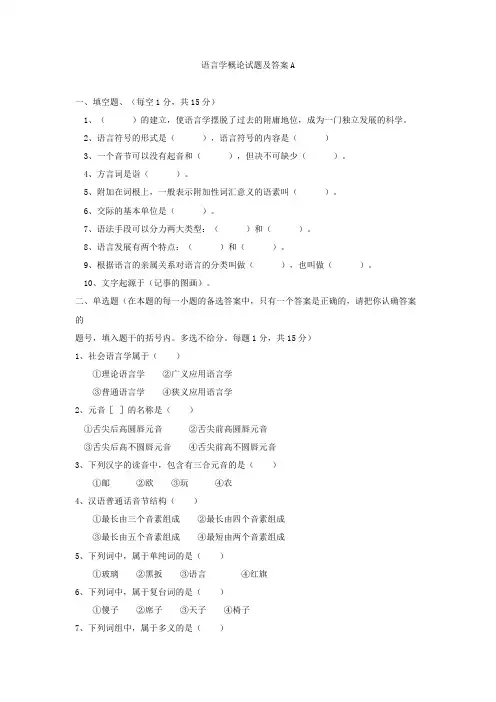
语言学概论试题及答案A一、填空题、(每空1分,共15分) 1、( )的建立,使语言学摆脱了过去的附庸地位,成为一门独立发展的科学。
2、语言符号的形式是( ),语言符号的内容是( ) 3、一个音节可以没有起音和( ),但决不可缺少( )。
4、方言词是诣( )。
5、附加在词根上,一般表示附加性词汇意义的语素叫( )。
6、交际的基本单位是( )。
7、语法手段可以分力两大类型:( )和( )。
8、语言发展有两个特点:( )和( )。
9、根据语言的亲属关系对语言的分类叫做( ),也叫做( )。
10、文字起源于(记事的图画)。
二、单选题(在本题的每一小题的备选答案中,只有一个答案是正确的,请把你认确答案的题号,填入题干的括号内。
多选不给分。
每题1分,共15分)1、社会语言学属于( )①理论语言学 ②广义应用语言学③普通语言学 ④狭义应用语言学2、元音[]的名称是( ) ①舌尖后高圆唇元音 ②舌尖前高圆唇元音 ③舌尖后高不圆唇元音 ④舌尖前高不圆唇元音3、下列汉字的读音中,包含有三合元音的是( ) ①邮 ②欧 ③玩 ④农4、汉语普通话音节结构( ) ①最长由三个音素组成 ②最长由四个音素组成③最长由五个音素组成 ④最短由两个音素组成5、下列词中,属于单纯词的是( ) ①玻璃 ②黑扳 ③语言 ④红旗6、下列词中,属于复台词的是( ) ①傻子 ②席子 ③天子 ④椅子7、下列词组中,属于多义的是( ) ①两只学生送的花瓶 ②两位学生送的花瓶③两只学生送的花篮。
④两个学生送的花篮8、下列词中粗体的成分,属于同音关系的是( ) ①杜鲁门——杜绝 ②负荆一负担 ③忽然--突然 ④花朵——浪花9、英语的‘foot”(脚,单数)变为“feet”(脚,复数)运用的语法手段是( ) ①附加 ②异根 ③内部屈折 ④重叠10、汉语普通话中的:“卡通片”中的“卡”是一个( ) ①语素 ②音节 ③前缀 ④词11、汉语中的:“了、着、过”在古代具有实实在在的词汇意义,到现代变成只表语义的助词, 这属于( ) ①异化 ②类化 ③新语法范畴的形成 ④实词虚化12、下列语言中属于粘着语的是( ) ①苗语 ②越南语 ③俄语 ④日语13、在一种语言内部划脑言时,最主要的依据是( ) ①语法 ②语义 ③语音 ④词汇14、下列词的词义,属于词义缩小的是( ) ①“皮”原指兽皮 ②“涕”原指眼泪③“瓦”原指一切烧好的上器 ④“江”原捐“长江”15、人类几种古老文字的原始字形,都是( ) ①象形的 ②会意的 ③表音的 ④形声的三、多选题(在本题的每一小题的备选答案中,正确答案有三个或三个以上多请把为正确答 案的题号,填入题干的括号内。
【十套】语言学概论试题(含解答)
导言:正在准备汉语言专业考试的无论是自考还有考研的同学都下来看看吧,这是目前网上能见到的最全面的普通语言学概论试题库的总结,附答案。
语言学概论试题(1)一、填空15%1、语言中最单纯、最常用、最原始和最能产的词是根词。
2、语言是人类最重要的交际工具,文字是最重要的辅助 交际工具。
3、我国古代学者为读懂古书而建立的训诂学、文字学、音韵学组成了我国的语文学,通称为“小学”。
4、英语属于印欧语系的日耳曼语族的西部语支。
5、语音可以从生理角度分析它的产生方式,从物理 角度分析它的表现形式(传递过程),从社会功能角度分析它的功能作用。
6、是否能够独立(自由)运用,是区分词和语素的根本特点。
7、现代大多数国家的拼音文字的字母,大多直接来源于拉丁字母。
8、具有不同功能的三种最基本的语法单位是语素、词、句子。
9、语言发展的主要特点是渐变性和不平衡性。
10、 我国宪法(1982年)第19条明确规定“国家推广全国通用的普通话”。
二、选择题10%1、中国的传统语文学研究的薄弱环节是(D)A、文字学B、语音学C、词汇学D、语法学 2、汉语属于(B)A、屈折语B、词根语C、多式综合语D、粘着语3、一种语言中数量最少的是(B)A、音素B、音位C、语素D、音节4、文字的前身是(C)A、结绳记事B、手势C、图画记事D、实物记事5、派生词中包含(B)A、词尾B、词根C、虚词D、根词6、语音和语义结合的最小的语言单位是(C) A、音素B、义素C、语素D、音位7、汉语单词“忽然”出现的位置是(C) A、主语位置B、谓语位置 C、状语位置D、定语位置8、以下各种语言变体中,属于社会方言的是(D)A、土话B、客家话C、客套话D、黑话9、下列语素中属于自由语素的是(C)A、初B、视C、人D、民10、在语言结构的某一环节上能够互相替换, 具有某种相同作用的各个单位之间所形成的关系叫(D)A、转换关系B、组合关系C、层级关系D、聚合关系三、名词解释20%1、专语语言学:以具体语言作为研究对象的语言学。
语言学:语言学概论考试试题
语言学:语言学概论考试试题1、填空题语言学的三大发源地:()正确答案:中国、印度、希腊—罗马2、名词解释语言融合正确答案:是指某个民族或某个民族中一部分人放弃本民族的语言而专用其他民族的语言,一种语言取代其(江南博哥)他语言,成为不同民族共同的交际工具,又叫语言转用、语言同化或语言替换。
3、多选下列有关普通话的表述中,正确的有()A.以北京语音为标准音B.以北京话为基础方言C.以北方方言为基础方言D.以典范的现代白话文著作为语法规范E.以历代经典的文学作品为语法规范正确答案:A, C, D4、名词解释通语正确答案:或称凡语、凡通语、通名等,是杨雄《方言》一书用来指西汉时没有地域限制,通行比较广的共同语的术语。
5、名词解释词汇意义(词义)正确答案:由人们对现实现象的反映以及由此带来的人们对现实现象的主观评价。
词典的释义所说明的一般都是词的词汇意义。
6、填空题根据语言的亲属关系对语言的分类叫做(),也叫做()。
正确答案:语言的谱系分类、语言的发生学分类7、单选下面词组中,结构类型与其他各组不同的一组是()A.年轻漂亮/朴素大方B.我们大家/首都北京C.铁路民航/工人农民D.贯彻执行/讨论研究正确答案:B8、名词解释社会语言学正确答案:用社会学的方法研究社会上的形形色色的语言变异等问题9、问答题简答复元音与几个相连的单元音的区别。
正确答案:复元音的几个成分同属于一个音节,发音时发音器官只有一次肌肉紧张;相连的单元音则各自分属于不同的音节,发音时有几个元音就有几次肌肉紧张;复元音是一个整体,发音时发音器官的运动是连续滑动的,元音的音质是不间断地逐渐变化的,中间会产生一连串的过渡音。
几个相连的单元音是彼此独立的整体,发音时发音器官的运动是跳跃式的,元音的音质是突变的,中间没有过渡音。
10、填空题句子结构关系的意义可以分为()意义和()意义两种。
正确答案:显性;隐性11、名词解释单纯字符正确答案:不能再分解为更小字符的字符。
语言学概论试题及答案
语言学概论试题及答案一、语言学概论试题1. 试论语言学的研究对象及其特点。
(200字)2. 语言学的基本理论有哪些?简要介绍。
(300字)3. 什么是语音学?试述语音学的主要研究内容。
(300字)4. 什么是词法学?试述词法学的主要研究内容。
(300字)5. 请列举并简单解释语用学的几个基本概念。
(200字)6. 语言学研究对语言教学有何意义?(200字)二、语言学概论试题答案1. 试论语言学的研究对象及其特点语言学是研究人类语言的科学,其研究对象是语言本身。
语言学的研究对象包括语音、词汇、句法、语义、语用等方面的内容。
语言学的主要特点是:(1) 多样性:世界上存在着众多的语言,每一种语言都具有自己独特的特点和规律。
(2) 普遍性:语言是人类共同的工具,几乎每个人都使用某种语言进行交流。
(3) 双重系统:语言既是一个符号系统,也是一种社会行为。
它既具有内部结构,又具有外部功能。
(4) 动态性:语言随着时间的推移而变化,不断发展演变。
2. 语言学的基本理论语言学的基本理论包括语音学、词法学、句法学、语义学和语用学。
语音学研究语音的产生、传播、听觉接收和知觉加工等方面的规律。
它分为音位学和音系学两个方面,前者研究语音的最小差别单元和它们在词汇中的组合规则,后者则研究语音的整体结构和系统性。
词法学研究词汇的形态、内部结构和词义等方面的规律。
它包括词形变化、构词法和词义学等内容。
句法学研究句子的结构和规则。
它研究句子的组成成分、句子的类型和句子的句法规则等内容。
语义学研究词语、短语和句子的意义。
它研究语言符号与其所指的客观事物之间的关系。
语用学研究语言使用的规则和范围。
它研究言语行为的目的、语境的作用以及交际中的语义推断等内容。
3. 语音学语音学是研究语音的学科,其主要研究内容包括语音的产生、传播、听觉接收和知觉加工等方面的规律。
语音的产生是指人类通过发声器官产生语音信号的过程。
它涉及到声带的振动、空气的流动以及口腔和喉部等器官的运动。
语言学概论试题及答案
语言学概论试题及答案语言学概论试题及答案语言学概论试题及答案(精选4份)语言学概论试题及答案(一):1.下列关于威尔尼克失语症的表述,不正确的一项是。
A.发音仍然比较准确B.构成不完整的句子C.仍然能听懂别人的话D.词语之间没有联系答案:C解析:威尔尼克取受损的患者能够说出一些词语,发音也很准确,可是词语之间在意义上没有联系,构成不了完整的句子,并且患者也听不懂别人说的话。
考点:语言与科学技术生命科学和人的语言本事人脑语言本事的研究成果2.人的大脑语言功能的临界期此刻一般认为大约是。
A.5-6岁B.7-8岁C.9-10岁D.12-13岁答案:D解析:人的大脑语言功能的临界期此刻一般认为最迟大约是12-13岁。
考点:语言与科学技术生命科学和人的语言本事大脑的语言功能受临界期限制3.老刘有三个孩子的蕴含义可能有。
A.老刘没有孩子B.老刘仅有三个孩子C.老刘有不止三个孩子D.老刘有孩子E.老刘没有三个孩子答案:BCD解析:蕴含义指说出的话中包含着其中某个词语的上位义或整体义,分为两种衍推义和隐含义。
D为衍推义,BC为隐含义。
考点:语用会话准则和会话含义蕴含义和预设义4.下头各对词语中,能表此刻同一语法位置上的有。
A.小孩-苹果B.大-小C.红-红色D.写-在E.好-衣服答案:ABD解析:能表此刻同一个语法位置上词,他们是属于聚合关系,聚合关系得到的是词类。
A是名词,B是形容词,D是动词。
考点:语法组合规则和聚合规则词的聚合:词类5.下头各项中属于词的有。
A.吃败仗B.转基因C.幼儿园D.小女儿E.玩游戏答案:BCD解析:词是最小的、有意义的、能够独立使用的语言单位。
A属于语,长度相当于语法上的词组或句子,但意义和用法相对凝固的语言片段。
E属于短语。
考点:语汇语汇概说什么是语汇6.医生安慰重病人说:没什么大问题,好好回家休养明显违反了。
A.赞誉准则B.慷慨准则C.相关准则D.一致准则E.质量准则答案:CE解析:为了避免患者受到损害,遵守礼貌原则,医生被迫违反了合作原则中相关原则和质量准则。
- 1、下载文档前请自行甄别文档内容的完整性,平台不提供额外的编辑、内容补充、找答案等附加服务。
- 2、"仅部分预览"的文档,不可在线预览部分如存在完整性等问题,可反馈申请退款(可完整预览的文档不适用该条件!)。
- 3、如文档侵犯您的权益,请联系客服反馈,我们会尽快为您处理(人工客服工作时间:9:00-18:30)。
一、单项选择题(每小题1分,共20分)在下列每小题的四个备选答案中选出一个正确的答1. Which of the following words is entirely arbitrary?__________A. treeB. crashC. typewriterD. bang2. ________ made the distinction between competence and performance.A. SaussureB. ChomskyC. BloomfieldD. Sapir3. Conventionally a ______ is put in slashes.A. allophoneB. phoneC. phonemeD. morpheme4. The word “hospitalize” is an example of __________.A. compoundB. derivationC. inflectionD. blending5. Constituent sentences is the term used in ___________.A. structural linguisticsB. functional analysisC. TG GrammarD. traditional grammar6. Cold and hot is a pair of ___________ antonyms.A. gradableB. complementaryC. reversalD. converse7. According to Searle, those illocutionary acts whose point is to commit the speaker to some futurecourse of action are called________.A. commissivesB. directivesC. expressiveD. declaratives8. Speech variety may be used instead of _______.A. vernacular language, dialect, pidgin, creoleB. standard languageC. both A and BD. none of the above9.______ deals with how language is acquired, understood and produced.A. SociolinguisticsB. PsycholinguisticsC. PragmaticsD. Morphology10. Discovering procedures are practiced by ________.A. descriptive grammarB. TC GrammarC. traditional grammarD. functional grammar11. The function of the sentence “Water boils at 100 degrees centigrade” is _________.A. interrogativeB. directiveC. informativeD. performative12. _________ refers to the abstract linguistic system shared by all the members of a speech community.A. ParoleB. LangueC. SpeechD. Writing13. The opening between the vocal cords is sometimes referred as _________.A. glottisB. vocal cavityC. pharynxD. uvula14. ________ refers to the study of the internal structure of words, and the rules by which words areformed.A. MorphologyB. SyntaxC. SemanticsD. Phonology15. “When did you stop taking this medicine?” is an example of _________in sense relationships.A. entailmentB. presuppositionC. assumptionD. implicature16. Idioms are ________.A. sentencesB. naming unitsC. phrasesD. communication units17. An illocutionary act is identical with________.A. sentence meaningB. the speaker’s intentionC. language understandingD. the speaker's competence18. In sociolinguistics, ______ refers to a group of institutionalized social situations typically constrainedby a common set of behavioral rules.A. domainB. situationC. societyD. community19. ______ refers to the gradual and subconscious development of ability in the first language by using itnaturally communicative situations.A. LearningB. CompetenceC. PerformanceD. Acquisition20. In which of the following stage did Chomsky add the semantic component to his TG Grammar forthe first time? __________A. The Classic TheoryB. The Standard TheoryC. The Extended Standard TheoryD. The Minimalist Program1. In Chinese when someone breaks a bowl or a plate the host or the people present arelikely to say sui sui ping an (every year be safe and happy)as a means of controlling theforces which the belivers feel might affect their lives. Which function does it perform?__________A. interrogativeB. EmotiveC. PerformativeD. Recreational2. Which of the following properties of language enables language users to overcome the barriers caused by time and place, due to this feature of language, speakers of a language are free to talk about anything in any situation? ___________A. InterchangeableB. DualityC. DisplacementD. Arbitrariness.3. Which of the following is not the major branch of linguistics? ___________A. PhonologyB. PragmaticsC. SyntaxD. Speech4._______ deals with language application to other fields, particularly education.A. Linguistic geographyB. SociolinguisticsC. Applied linguisticsD. Comparative linguistics5. A phoneme is a group of similar sounds called_________.A. minimal pairsB. allomorphsC. phonesD. allophones6. Which one is different from the others according to manners of articulation? _________A. [z]B. [w]C. [h]D. [v]7.________ doesn’t belong to the most productive means of word-formation.A. AffixationB. CompoundingC. ConversionD. Blending8. Nouns, verbs, and adjectives can be classified as __________.A. lexical wordsB. grammatical wordsC. function wordsD. form words9. ________ refers to the relations holding between elements replaceable with each other at particular place in structure, or between one element present and the others absent.A. Syntagmatic relationB. Paradigmatic relationC. Co-occurrence relationD. Hierarchical relation10. According to Standard Theory of Chomsky, ________ contain all the informationnecessary for the semantic interpretation of sentences.A. deep structureB. surface structuresC. transformational rulesD. PS-rules11. ________describes whether a proposition is true or false.A. TruthB. Truth valueC. Truth conditionD. Falsehood12. “John hit Peter” and “Peter was hit by John” are the same ________.A. propositionB. sentenceC. utteranceD. truth13. ________ is a branch of linguistics which is the study of meaning in the context of use.A. MorphologyB. SyntaxC. PragmaticsD. Semantics14. ________is the study of how speaker of a language use sentences to affect successfulcommunication.A. SemanticsB. PragmaticsC. SociolinguisticsD. Psycholinguistics15.______is defined as any regionally or socially definable human group identified byshared linguistic system.A. A speech community A. A raceC. A societyD. A country16.______variation of language is the most discernible and definable in speech variation.A. RegionalB. SocialC. StylisticD. Idiolectal17. In first language acquisition children usually _________ grammatical rules from thelinguistic information they hear.A. useB. acceptC. generalizeD. reconstruct18. By the time children are going beyond the ______ stage, they begin to incorporate someof the inflectional morphemes.A. telegraphicB. multiwordC. two-wordD. one-word19. According to Halliday, the three metafunctions of language are ________.A. ideational, interpersonal and textualB. ideational, informative and textualC. metalinguistic, interpersonal and textualD. ideational, interpersonal and referential20. The person who is often described as “'father of modern linguistics” is _______.A. FirthB. SaussureC. HallidayD. Chomsky1. Study the following dialogue. What function does it play according to the functions of language? ___________- A nice day, isn’t it?- Right! I really enjoy the sunlight.A. EmotiveB. PhaticC. PeformativeD.Interpersonal2. Unlike animal communication systems, human language is __________.A. stimulus freeB. stimulus boundC. under immediate stimulus controlD. stimulated by some occurrence of communal interest3. Which branch of linguistics studies the similarities and differences among language?___________A. Diachronic linguisticsB. Synchronic linguisticsC. Prescriptive linguisticsD. Comparative linguistics4. __________ has been widely accepted as the forefather of modern linguistics.A. ChomskyB. SaussureC. BloomfieldD. John Lyons5. Which vowel is different from the others according to the tongue position of vowels?___________A. [i]B. [u]C. [e]D.[a]6. Liquids are classified in the light of __________.A. manner of articulationB. place of articulationC. place of tongueD. none of the above7. Morphemes that represent tense, number, gender and case are called _____ morphemes.A. inflectionalB. freeC. boundD. derivational8. There are _______ morphemes in the word denationalization.A. threeB. fourC. fiveD. six9. In English, theme and rhyme are often expressed by ________ and ________.A. subject, objectB. subject, predicateC. predicate, objectD. object, predicate10. The semantic triangle holds that the meaning of a word ________.A. is interpreted through the mediation of conceptB. is related to the thing it refers toC. is the idea associated with that word in the minds of speakersD. is the image it is represented in the mind.11. “John killed Bill but Bill didn’t die” is a (n) ___________.A. entailmentB. presuppositionC. anomalyD. contradiction12. ________ found that natural language had its own logic and concludes cooperativeprinciple.A. John AustinB. John FirthC. Paul GriceD. William Jones13. _______ proposed that speech acts can fall into five general categories.A. AustinB. SearleC. SapirD. Chomsky14. ______ is not a typical example of official bilingualism.A. CanadaB. FinlandC. BelgiumD. Germany15. The most recognizable difference between American English and British English are in_____ and vocabulary.A. diglossiaB. bilingualismC. pidginizationD. blending16. ______ transfer is a process that is more commonly known as interference.A. AcquisitionB. PositiveC. NegativeD. Interrogative17. In general, the two-word stage begins roughly in the _____ half of the child’s secondyear.A. earlyB. lateC. firstD. second18. The most important contribution of the Prague School to linguistics is that it seeslanguage in terms of ________.A. functionB. meaningC. signsD. system19. The principal representative of American descriptive linguistics is________.A. BoasB. SapirC. BloomfieldD. Harris20. At the _______ stage negation is simply expressed by single words with negativemeaning.A. prelinguisticsB. multiwordC. two-wordD. one-word1. Which of the following is the most important function of language? ___________A. Interpersonal functionB. Performative functionC. Informative functionD. Recreational function2. In different languages, different terms are used to express the animal "狗", this shows thenature of ______ of human language.A. arbitrarinessB. cultural transmissionC. displacementD. discreteness3. The study of language as a whole is often called ____________.A. general linguisticsB. sociolinguisticsC. psycholinguisticsD. applied linguistics4. The study of language meaning is called __________.A. syntaxB. semanticsC. morphology D pragmatics5. In English, there is one glottal fricative. It is _______.A. [I]B. [h]C. [k]D. [f]6. The phonetic symbol for “voiced bilabial glide” is _________.A. [v]B. [d]C. [f]D. [w]7. In English -ise and -tion are called ________.A. prefixesB. suffixesC. infixesD. free morphemes8. Morphology is generally divided into two fields: the study of word-formation and ______.A. affixationB. etymologyC. inflectionD. root9. The sense relationship between “John plays the violin” and “John plays a musicalinstrument” is ________.A. hyponymyB. antonymyC. entailmentD. presupposition10. Conceptual meaning is ________.A. denotativeB. connotativeC. associativeD. affective11. Promising, undertaking, vowing are the most typical of the_______.A. declarationsB. directivesC. sociolinguisticsD. Chomsky12. The violation of one or more of the conversational _______ (of the CP) can, when thelistener fully understands the speaker, create conversational implicatures, and humor sometimes.A. standardsB. principlesC. levelsD. maxim13. _______variety refers to speech variation according to the particular area where aspeaker comes from.A. RegionalB. SocialC. StylisticD. Register variety14. In a speech community people have something in common ______ -a language or aparticular variety of language and rules for using it.A. sociallyB. linguisticallyC. culturallyD. pragmatically15. The optimum age for SLA is _______.A. childhoodB. early teensC. teensD. adulthood16. In general, ________ language acquisition refers to children's development of theirlanguage of the community in which a child has been brought up.A. firstB. secondC. thirdD. fourth17. Children follow a similar ________ schedule of predictable stages along the route oflanguage development across cultures.A. learningB. studyingC. acquisitionD. acquiring18. The theory of _______ considers that all sentences are generated from a semanticstructure.A. Case GrammarB. Stratificational GrammarC. Relational GrammarD. Generative Semantics19. _______ grammar is the most widespread and the best understood method of discussingIndo-European language.A. TraditionalB. StructuralC. FunctionalD. Generative20. Hjelmslev is a Danish linguist and the central figure of the ______.A. Prague SchoolB. Copenhagen SchoolC. London SchoolD. Generative Semantics21. The relation between form and means in human language is natural.22. Descriptive linguistics studies one specific language.23. Phonetics is the science that deals with the sound system.24. Phonology is the study of speech sounds of all human languages.25. All consonants are produced with vocal-cord vibration.26. Inflectional morphology is one of the two sub-branches of morphology.27. The structure of words is not governed by rules.28. If a word has sense, it must have reference.29. “He didn't stop smoking” presuppo ses that he had been smoking.30. A locutionary act is the act of expressing the speaker’s intention.31. A text is best regarded as a semantic unit, a unit not of form but of meaning.32. Although the age at which children will pass through a given stage can vary significantfrom child to child, the particular sequence of stages seems to be the same for all children acquiring a given language.33. It’s normally assumed that, by the age of five, with an operating vocabulary of more2,000 words, children have completed the greater part of the language acquisition process.34. “Tom hit Mary and Mary hit Tom” is an exocentric construction while “men andwomen” is an endocentric construction.35. Following Saussure’s distinction between langue and parole, Trubet zkoy argued thatphonetics belonged to langue whereas phonology belonged to parole.36. The subject-predicate distinction is the same as the theme and functional linguistics.37. Langue refers to the abstract linguistic system shared by all the members of a speechcommunity.38. Consonant sounds can be either voiced or voiceless, while all vowel sounds arevoiceless.39. The standard language is a superposed, socially prestigious dialect of language.40. An illocutionary act is identical with the speaker’s intention.21. When language is used to get information from other, it serves an informative function.22. All the English words are not symbolic.23. All sounds produced by human speech organs are linguistics symbols.24. There are 72 symbols for consonants and 25 for vowels in English.25. The sound [z] is an oral voiced post-alveolar fricative.26. A morpheme is the basic unit in the study of morphology.27. Derivational affixes are added to an existing form to create a word.28. The grammatical meaning of a sentence refers to its grammaticality.29. There is only one argument in the sentence “Kids like apples”.30. While conversation participants nearly always observe the CP, they do not alwaysobserve these maxims strictly.31. Inviting, suggesting, warning, ordering are instance of commissives.32. Cohesion and coherence is identical with each other in essence.33. It has been recognized that in ideal acquisition situation, many adults can reachnative-like proficiency in all aspects of a second language.34. All roots are free morphemes while not all free morphemes are roots.35. In the Classical theory, Chomsky’s aim is to make linguistics a science. This theory ischaracterized by three features: emphasis on prescription of language, introduction of transformational rules, and grammatical description regardless of language formation. 36. Generative grammar is a system of rules that in some explicit and well-defined wayassigns structural descriptions to sentences.37. All words may be said to contain a root morpheme.38. Phrase structure rules allow us to better understand how words and phrases formsentences, and so on.39. Promising, undertaking, vowing are the most typical of the psycholinguistics.40. Halliday’s Systemic Grammar contains a functiona l component, and the theory behindhis Function Grammar is systemic.21. Most animal communication systems lack the primary level of articulation.22. Langue is more abstract than parole and therefore is not directly observable.23. General linguistics deals with the whole human language.24. Auditory phonetics investigates how a sound is perceived by the listener.25. In English, there are two nasal consonants. There are [m] and [n].26. Phonetically, the stress of a compound always falls on the first element, while thesecond element receives secondary stress.27. The meaning of the word we often used is the primary meaning.28. Meaning is central to the study of communication.29. Of the three speech acts, linguists are most interested in the illocutionary act becausethis kind of speech is identical with the speaker’s intention.30. As the process of communication is essentially a process of conveying meaning in acertain context, pragmatics can also be considered as a kind of meaning study.31. If a text has no cohesive words, we say the text is not coherent.32. The optimum age for SLA always accords with the maxim of “the younger the better”.33. In general, language acquisition refers to children’s development of their first language,that is, the native language of the community in which a child has been brought up.34. The London School is also known as systemic linguistics and functional linguistics.35. Coarticulation refers to the phenomenon of sounds continually show the influence oftheir neighbors.36. Band morphemes are independent units of meaning and can be used freely all bythemselves.37. In the history of American linguistics, the period between 1933 and 1950 is also knownas the Bloomfieldian Age.38. Paul Grice found that artificial language had its own logic and conclude cooperativeprinciple.39. Cultural transmission refers to the fact that language is cultural transmitted. It is passedon from one generation to the next through teaching and learning, rather than by instinct.40. Linguistic potential is similar to Saussure’s langue and Chomsky’s performance.21. Language change is universal, ongoing and arbitrary.22. Competence is more concrete than performance.23. Descriptive linguistics attempts to establish a theory which accounts for the rules oflanguage in general.24. The space between the vocal cords is called glottis.25. Stops can be divided into two types: plosives and nasals.26. All roots are free and all affixes are bound.27. The sentence “Tom, smoke!” and“Tom smokes” h ave the same semantic predication.28. The sentence that contains the same words is the same in meaning.29. A sentence is a grammatical unit and an utterance is a pragmatic notion.30. “John has been to Asia” entails“John has been to Japan”.31. Coherence is a logical, orderly and aesthetical relationship between parts, in speech,writing, or argument.32. Language acquisition is in accordance with language learning on the assumption thatthere are different processes.33. SLA is primarily the study of how learners acquire or learn an additional language afterthey acquired their first language.34. According to Firth, a system is a set of mutually exclusive options that come into play atsome point in a linguistic structure.35. American structuralism is a branch of diachronic linguistics that emerged independentlyin the United States at the beginning of the twentieth century.36. Phonological knowledge is a native speaker’s intuition about the sounds and soundpatterns of his language.37. Phonetics has three sub-branches: acoustic phonetics, auditory phonetics andarticulatory phonetics.38. The paradigmatical relation shows us the inner layering of sentences.39. An ethnic dialect is spoken mainly by a less privileged population that has experiencedsome sort of social isolation, such as racial discrimination.40. Searle proposed that speech act can fall into six general categories.41. _______ is the actual realization of one's linguistic knowledge in utterances.42. Combining two parts of two already existing words is called ________ inword-formation.43. Lexicon, in most cases, is synonymous with _______.44. A ________ is a structurally independent unit that usually comprises a number of wordsto form a complete statement, question or command.45. _______ studies the sentence structure of language.46. In semantic analysis, ________ is the abstraction of the meaning of a sentence.47. A speech _______is a group of people who share the same language or a particularvariety of language.48. In learning a second language, a learner will subconsciously use his L1 knowledge. Thisprocess is called language _______.49. The development of a first or native language is called first language________.50. ________ is a branch of linguistics which is the study of meaning in the context of use.41. In any language words can be used in new ways to mean new things and can becombined into innumerable sentences based on limited rules. This feature is usually termed _________ or creative.42. The description of a language as it changes through time is a ___________ study.43. The qualities of vowels depend upon the position of the _________ and the lips.44. Consonants differ from vowels in that the latter are produced without___________.45. ________________ is a reverse process of derivation, and therefore is a process ofshortening.46. For ______________________ antonyms, it is a matter of either one or the other.47. A ___________ language is originally a pidgin that has become established as a nativelanguage in some speech community.48. A linguistic _____________ refers to a word or expression that is prohibited by the“polite” society from general use.49. For the vast majority of children, language development occurs spontaneously andrequires little conscious _____________ on the part of adults.50. Systemic-Functional Grammar is a(n) _________________ oriented functionallinguistics approach.41. One general principle of linguistic analysis is the primacy of _______ over writing.42. ___________ is the branch of linguistics which studies the form of words.43. A word formed by derivation is called a ____________, and a word formed bycompounding is called a ___________.44. ____________ is a science that is concerned with how words are combined to formphrases and how phrases are combined by rules to form sentences.45. The ________________ relation is a kind of relation between linguistic forms in asentence and linguistic forms outside the sentence.46. The various meanings of a _____________ word are related to some degree.47. The pre-school years are a ____________ period for first language acquisition.48. Whorf proposed that all higher levels of thinking are dependent on ____________.49. _______________ deals with how language is acquired, understood and produced.50. Structuralism is based on the assumption that grammatical categories should be definednot in terms of meaning but in terms of ________________.41. Language is a system of arbitrary _________ symbols used for human communication.42. Langue or competence is _________ and not directly observable, while parole orperformance is concrete and directly observable.43. The vocal tract can be divided into two parts: the oral cavity and the __________.44. The combination of two or sometimes more than two words to create new words incalled _____________.45. The words of English are classified into native words and __________ words.46. Language itself is not sexist, but its use may reflect the ______________ attitudeconnoted in the language that is sexist.47. _____________ refers to the gradual and subconscious development of ability in thefirst language by using it naturally communicative situations.48. In first language acquisition children usually __________ grammatical rules from thelinguistic information they hear.49. The starting point of Chomsky's TG Grammar is his ___________ hypothesis.50. A ____________ analysis of an utterance will reveal what the speaker intends to dowith it.51. discreteness52. competence53. triphthongs54. bound morpheme55.syntax51. design features52. performance53. minimal pair54. morpheme55. polysemy51. arbitrarinessngue53.vowel54. affixs55. reference51. language52. phonemes, phones53. backformation54.lexical semantics55.speech community56. How does a linguist construct a rule?57. How can we decide a minimal pair or a minimal set?58. Explain the interrelations between semantic and structural classifications of morphemes.59. List the differences between surface structure and deep structure of a sentence.60. How does competence differ from performance?56. Explain the differences between langue and parole.57. Use examples to illustrate the difference between a compulsory constituent and an optional constituent.58. Define the two terms: phonemes and allophones.59. What are the three types of distribution?60. How many types of linguistic knowledge does a native speaker possess? What are they?56.What are the five sub-branches of linguistics?57. What are the suprasegmental features are?58. What is the difference between cohesion and coherence?59. What is ethnic dialect?60. What is learner language and target language?56. What is the difference between synchronic linguistics and diachronic linguistics?57. What are the functions of language?58.Explain the relationship between speech and writing.59. Analyze the word “disestablishment” by IC analysis:60.What does morphology study?61. What are the differences between inflectional and derivational affixes in terms of both function and position?61. List the differences between surface structure and deep structure of a sentence.61. Define the three types of distribution respectively.61. Describe with examples various types of morpheme used in English.。
